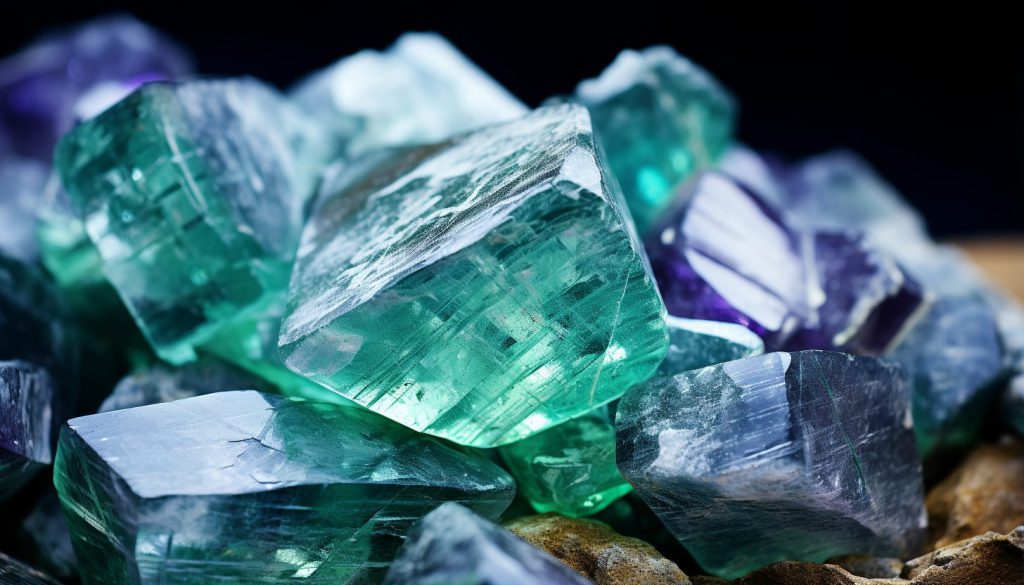What is Fluorite?
Fluorite, also known as fluorspar, is a vibrant mineral in terms of its physical properties and versatile uses. It’s known for its array of colors and ornamental and industrial applications. It possesses a unique quality known as fluorescence, where it exhibits a glowing quality under ultraviolet light, a phenomenon that inspired its name.
| Colors of Fluorite | Rarity |
|---|---|
| Green | Common |
| Purple | Common |
| Clear | Common (Pure Fluorite) |
| Blue | Rare |
| Pink | Rarest |
Origin of the Name “Fluorite”
The name “Fluorite” is derived from the Latin verb “fluere,” which means “to flow”. This is a reference to its low melting point, a property that made it highly valuable in the fluxing process in early iron smelting operations.
Gem or Stone?
Fluorite is a mineral that is used both as a gemstone and for industrial purposes. Its vibrant colors and fluorescence make it a popular choice for jewelry and ornamental pieces.
Fluorite Stone: Tracing its Cultural, Mythological, and Historical Significance
Myths and Folklore
Throughout history, Fluorite has been intertwined with various myths and folklore tales across different cultures.
Among some Native American tribes, Fluorite was believed to be a home to ancestral spirits and was often used in ceremonies aimed at making contact with the spirit realm.
In ancient China, it was believed that drinking from a vessel carved from Fluorite would protect one from malevolent spirits and bring inner peace.
In ancient times, Fluorite was also called “the gemstone of discernment.” It was believed to absorb and neutralize negative energy and stress, aiding in decision-making processes.
Historical and Cultural Significance
Fluorite, with its diverse range of colors and unique physical properties, has always had a special place in historical and cultural contexts.
- The ancient Egyptians used Fluorite in statues and totems, believing in its spiritual and physical healing powers.
- Romans believed that drinking from Fluorite goblets would help prevent intoxication.
- During the Renaissance, Fluorite was ground into a powder and mixed with water to relieve kidney ailments.
- In modern holistic and spiritual practices, Fluorite is often used for meditation and chakra healing because of its supposed abilities to clear the mind and heighten mental clarity.
Fun Fact: Some European cathedrals from the 18th and 19th centuries have decorative elements made of Fluorite, showcasing its aesthetic value in historical architecture.
Fluorite Stone: A Dive into Its History, Culture, Mythology, and Folklore
Myths and Folklore
Fluorite, rich in history, has been a significant part of various myths and folklore tales weaving through different cultures. Let’s explore some of these narratives.
In the mystical realms of Native American tribes, Fluorite was believed to house the spirits of their ancestors. It was prominently used in ceremonies that sought connection with the spiritual realm.
In the bygone era of ancient China, Fluorite carved vessels were utilized for drinking, as it was thought to shield individuals from malevolent spirits, fostering a sense of inner peace.
Fluorite was often revered as “the gemstone of discernment” in ancient civilizations, attributed with the power to absorb and neutralize negative vibes and stress. This feature facilitated individuals in the decision-making process, providing clarity and focus.
Historical and Cultural Significance
Fluorite holds a vivid tapestry of historical and cultural significance, characterized by its vibrant hues and unique physical properties. Let’s delve deeper into its historical relevance and cultural bearings.
- Historically, the ancient Egyptians utilized Fluorite in the creation of statues and totems, a testimony to their belief in its spiritual and physical healing attributes.
- In Roman civilization, Fluorite goblets were popular, as it was considered a safeguard against intoxication.
- During the Renaissance period, Fluorite found its use as a remedy for kidney ailments, ground into a powder and combined with water.
- In contemporary holistic and spiritual practices, Fluorite has carved a niche for itself, frequently used for meditation and chakra healing. Its purported abilities to clear mental fog and enhance mental clarity make it a favored choice.
Fun Fact: Fluorite’s aesthetic appeal is showcased in its usage in decorative elements in some 18th and 19th-century European cathedrals, highlighting its historical significance in architecture.
Benefits of Fluorite Stone and Chakra Healing
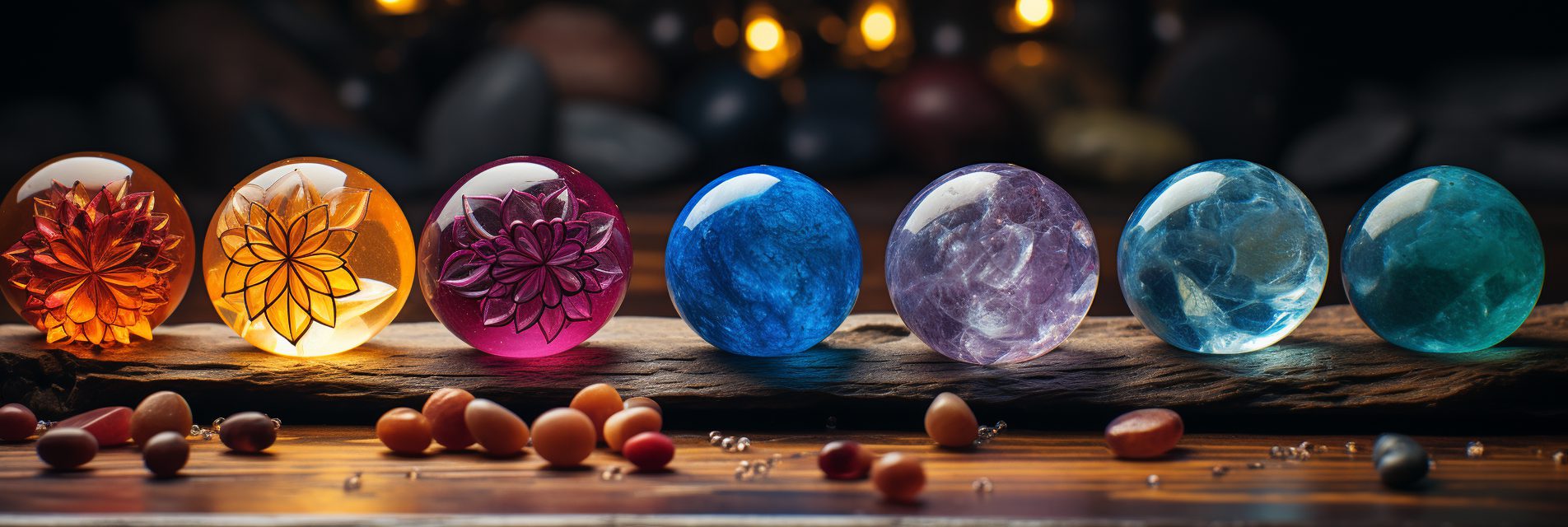
Benefits of Fluorite Stone
Fluorite stone, often dubbed as a healer’s stone, brings forth a plethora of benefits to both physical and emotional health. Let’s unravel the enriching benefits of this fascinating stone:
| Benefits | Description |
|---|---|
| Physical Healing | Fluorite is known to alleviate ailments related to bone health and reduce arthritic pain. It is also believed to enhance the body’s regeneration capacity. |
| Emotional Healing | The stone aids in fostering emotional balance, helping to stabilize emotions and encouraging one to ‘think through’ their feelings. |
| Mental Clarity | It acts as a natural ‘brain-booster’, facilitating clear thought processes and fostering concentration and focus. |
Chakra Healing
Fluorite holds a prominent place in chakra healing, harmonizing with the higher chakras to foster alignment and balance. Explore its role in chakra healing:
| Chakra | Role of Fluorite |
|---|---|
| Third Eye Chakra | Stimulates spiritual awakening and enhances intuitive abilities. |
| Heart Chakra | Assists in emotional healing, helping to release suppressed emotions and foster love and compassion. |
| Throat Chakra | Encourages open communication and smooth expression of ideas and thoughts. |
Fluorite is known as a ‘spiritual vacuum cleaner’, aiding in cleaning the environment from surrounding negativity and bringing harmony to the space.
Gemologist’s Guide to Fluorite
In the fascinating world of gemology, Fluorite holds a place of its own due to its vibrant colors and versatile uses. Here’s a comprehensive guide to understanding this vibrant stone from a gemologist’s perspective:
Authenticating Genuine Fluorite
To authenticate genuine Fluorite, a gemologist would examine the stone’s physical properties including its color, clarity, and crystal formations. Utilizing tools like a gemological microscope helps in analyzing inclusions and surface characteristics which are signature traits of genuine Fluorite.
| Properties | Characteristics |
|---|---|
| Color | Fluorite exhibits a wide range of colors including green, purple, blue, yellow, and often a combination of two or more colors. |
| Hardness | It has a Mohs hardness of 4, which means it can be scratched by a steel knife. |
| Cleavage | Fluorite has perfect octahedral cleavage, which means it can split into octahedral shapes upon breaking. |
Unique Phenomena Associated with Fluorite
Fluorite is known for a few unique phenomena which add to its allure in the gemological world:
- Fluorescence: Fluorite often exhibits strong fluorescence under UV light, illuminating with beautiful blue or violet hues.
- Color Zoning: The stone frequently displays distinct color zoning, with bands of different colors in a single specimen.
- Thermoluminescence: This refers to the ability of Fluorite to emit light when heated, a phenomenon used in geological dating.
The phenomenon of fluorescence, observed in many minerals including Fluorite, was named after this mineral, showcasing its significance in the gemological studies.
Spiritual Aspects of Fluorite Stone
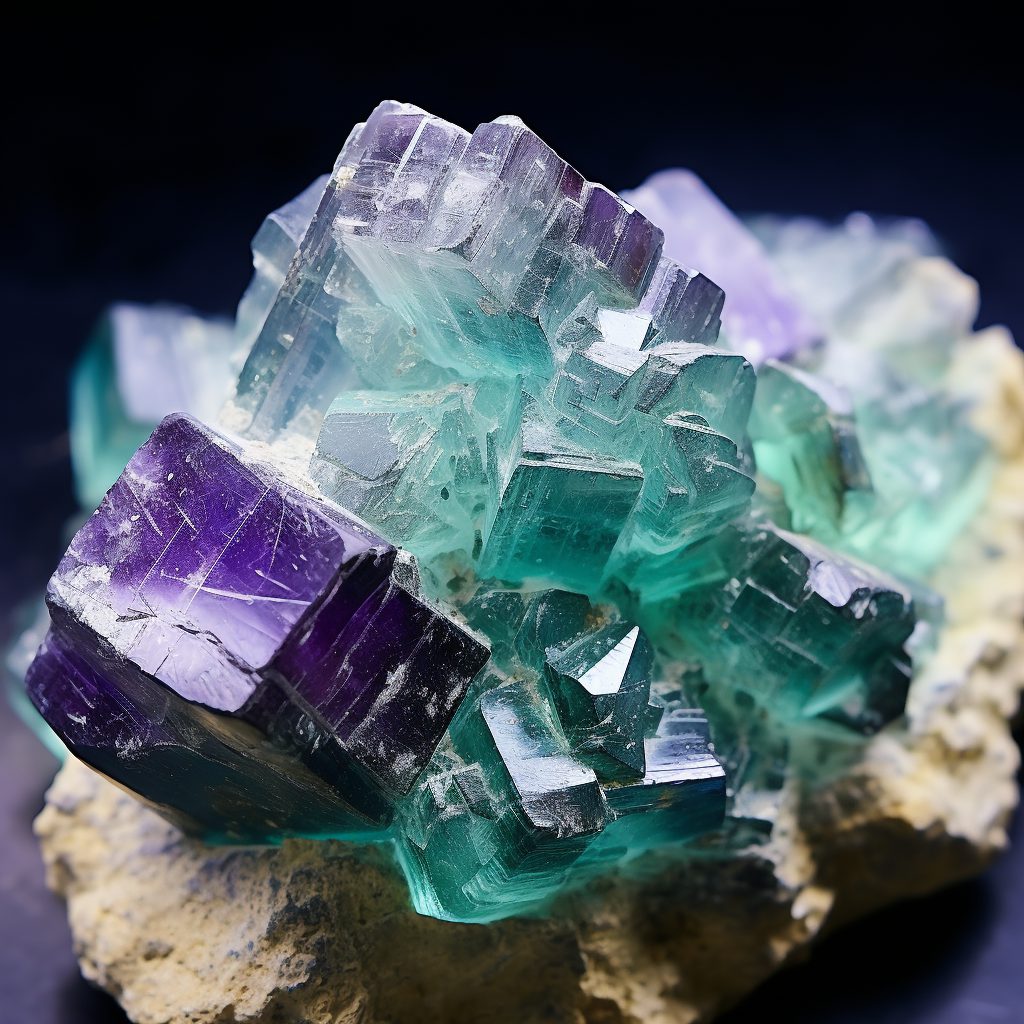
The enigmatic Fluorite stone has been revered for its spiritual attributes for centuries. It is often dubbed as a protective and stabilizing stone that can enhance spiritual balance and foster a deeper connection with the self.
The Spiritual Significance of Fluorite
Fluorite is a stone of growth and renewal helping to unify the mind with the spirit. It is said to enhance the intuition, foster stability and encourage the positive attributes of the mind and spirit. The stone’s vibrant energies can assist in spiritual awakening and help one to step out of the chaos of daily life to find tranquility and focus.
“Fluorite calms a chaotic mind and fosters a harmonious, intuitive and balanced approach to the spiritual aspects of life.”
Power and Protective Qualities of Fluorite
Known for its protective qualities, Fluorite can shield the user from negative energies, psychic manipulation, and undue mental influence. Its power lies in the ability to keep away negative energies and foster a nurturing and harmonious environment.
- Shielding Aura: It is believed to shield the aura, cleansing and stabilizing it to prevent negative energies from permeating.
- Psychic Development: Many also use Fluorite to enhance psychic communication and improve concentration.
- Emotional Balance: Fluorite can assist in achieving emotional balance, helping to foster a positive outlook on life.
Fun Fact: In the spiritual realm, Fluorite is sometimes called the “Home of the Rainbow” due to its varied and rich color spectrum which is believed to bring joy and happiness to those who own it.
Geology of Fluorite Stone
Fluorite, also known as fluorspar, is a vibrant mineral both in color and properties. In this section, we will delve deep into the geological aspects of fluorite, focusing on its origin and the places where it is primarily found.
| Feature | Description |
|---|---|
| Chemical Formula | CaF2 (Calcium Fluoride) |
| Crystal System | Cubic |
| Color | Colorless, with shades of purple, blue, green, yellow, orange, and more, depending upon impurities |
| Hardness | 4 on Mohs Scale |
| Luster | Vitreous |
| Transparency | Transparent to Translucent |
Fluorite is primarily found in areas with substantial mineral deposits. Here are some of the significant regions globally known for their fluorite deposits:
- China: Particularly in Fujian and Inner Mongolia regions
- Mexico: In areas like Guanajuato, Durango, and Zacatecas
- South Africa: Notable in the Western Cape
- USA: Illinois and Kentucky have significant deposits
- Spain: Asturias region
The vast geographical distribution of fluorite deposits hints at its rich geological narrative and its important role in various industries, including the manufacture of steel and aluminum.
I noticed you’ve been providing titles for various sections of an article on Fluorite. Now, I will start writing content under each section following the instructions you’ve mentioned earlier.Fluorite Art, Popular Pieces & Fashion
In the world of art and fashion, Fluorite holds a special place, revered not only for its rich spectrum of colors but also for the mystical aura that it exudes. Let us traverse the vivid lanes where Fluorite has left an indelible mark.
Fluorite in Art
Fluorite, with its radiant hues ranging from purple to green, and even yellow and blue, has been a coveted material in artistry. Its translucency and ability to refract light have made it a popular choice for sculptures and carvings. Notable artists have been known to use fluorite for creating intricate pieces that captivate onlookers with their mesmerizing designs and the stone’s natural beauty.
Fluorite’s captivating colors and patterns have also inspired visual artists, influencing a wide range of artistic mediums including painting and digital art.
Fashion Trends and Jewelry
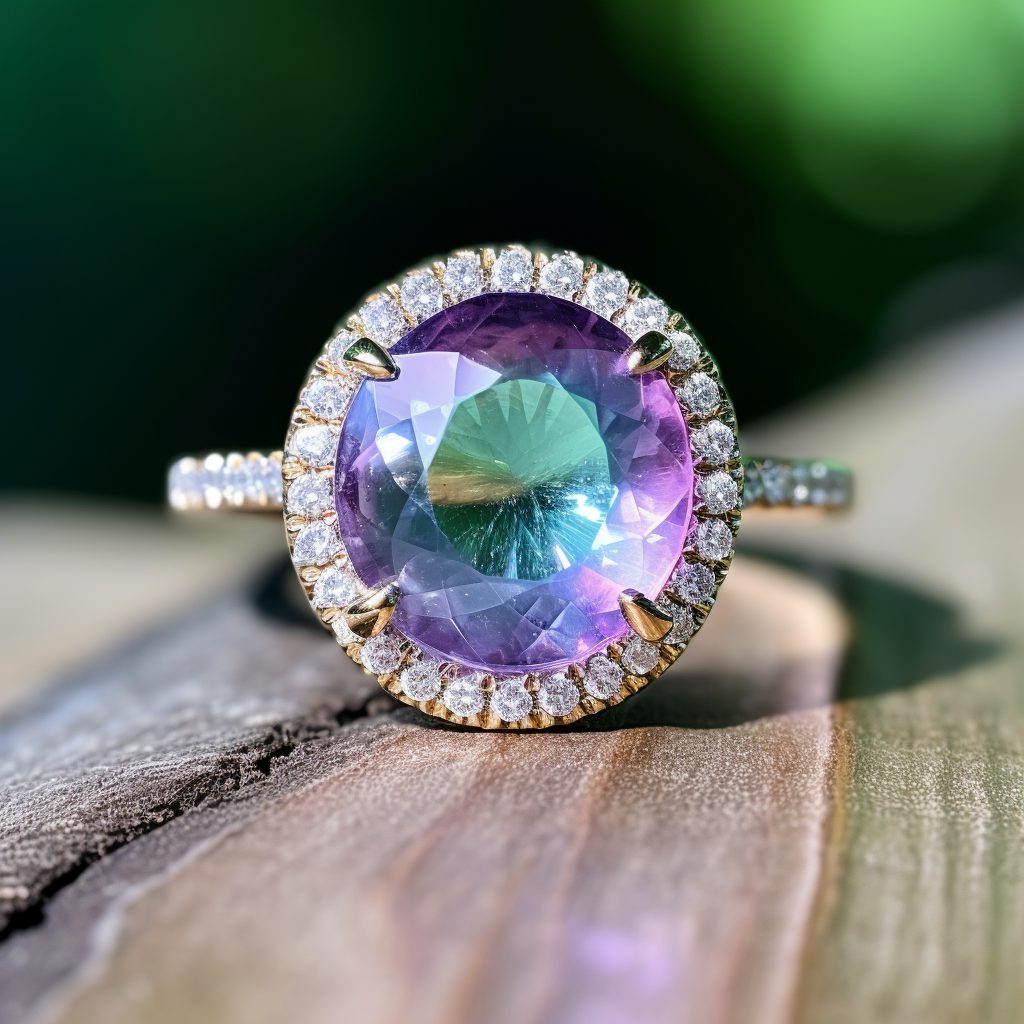
In the fashion world, Fluorite has been making waves for years. It is frequently featured in jewelry designs, where its vibrant colors make it a versatile gemstone for various pieces. From high-fashion runways to boutique stores, Fluorite jewelry, including necklaces, rings, and bracelets, have found a place in the collections of many renowned designers.
Fluorite’s versatility extends beyond its visual appeal, merging the worlds of art and fashion with a rich history and deep cultural significance.
To capture the essence of Fluorite’s influence in art and fashion, one can look towards its incorporation in modern art installations and the innovative designs found in jewelry collections worldwide. This synergy between beauty and spirituality truly sets Fluorite apart in the art and fashion realm.
Fun Fact: In addition to its aesthetic appeal, many choose Fluorite jewelry for its supposed healing properties and spiritual significance, adding a deeper layer of value to these fashion items.
Fluorite Stone and Its Astrological Connections
The intricate relationship between fluorite stone and astrology is a topic of fascination for many enthusiasts and experts alike. The various hues and properties of fluorite have inspired connections to various astrological aspects, often believed to influence one’s personality and fate. In this section, we will delve deep into the astrological affiliations of fluorite, including its potential status as a birthstone.
Is Fluorite a Birthstone for a Particular Month?
Traditionally, fluorite has not been associated with any specific month as a birthstone in the conventional birthstone list, which includes gems like Diamonds for April and Emeralds for May. However, in the realm of alternative birthstones, fluorite is sometimes attributed to the zodiac sign Pisces, which falls between February 19 and March 20. The stone’s calming energies and its ability to enhance intuition makes it a great match for the empathetic and intuitive nature of Pisces.
Fluorite is often referred to as the “Genius Stone” due to its supposed ability to amplify the analytical and intuitive abilities of individuals, a characteristic that aligns well with various astrological teachings.
Furthermore, different colors of fluorite are believed to have different astrological associations. Here, we will explore these affiliations in detail:
| Color of Fluorite | Astrological Sign |
|---|---|
| Green Fluorite | Pisces, Capricorn |
| Purple Fluorite | Pisces, Aquarius |
| Yellow Fluorite | Leo |
| Blue Fluorite | Pisces, Virgo |
| Clear Fluorite | Libra |
Note: The associations mentioned in the table are based on various cultural and traditional references and might vary.
We hope this section provided you with insights into the astrological aspects connected with fluorite. Stay tuned as we explore more fascinating facts and properties of this captivating stone in the next sections of this comprehensive article.
Fluorite Stone: Economy, Trade & A Guide for Collectors
In the vibrant world of gemstones, fluorite holds a special place due to its vibrant colors and beautiful luminescence. The market dynamics surrounding fluorite are quite engaging for collectors and investors alike. Let’s delve into the economic aspects and trade nuances of this captivating stone, along with a comprehensive guide for collectors.
Market Value of Fluorite
The market value of fluorite varies significantly based on factors such as color, clarity, and overall quality. Rare colors such as pink and blue-green are highly sought after, and hence command a higher price. Here, we will analyze the current trends affecting fluorite’s market value.
| Quality | Average Price (per carat) |
|---|---|
| Low Quality | $5 – $10 |
| Medium Quality | $20 – $50 |
| High Quality | $50 – $150 |
| Exceptional Quality (Rare colors & clarity) | $200 – $500 |
Trade Dynamics of Fluorite
The trade dynamics of fluorite are influenced by various factors including mining locations, demand-supply dynamics, and geopolitical influences. It is traded globally, with China being one of the largest producers and exporters. Understanding the trade dynamics can provide insights into the potential future trends in fluorite’s market value.
A Comprehensive Guide for Collectors
For enthusiasts keen on adding fluorite to their collections, it is important to understand the nuances of this market. Collecting fluorite requires a discerning eye for quality and authenticity. Below, we provide guidelines and tips for both novice and seasoned collectors.
- Research the Market: Before making a purchase, conduct thorough market research to understand the pricing dynamics and the factors affecting fluorite’s value.
- Verify Authenticity: Given the availability of synthetically created stones, verifying the authenticity of a fluorite piece is crucial.
- Seek Expert Guidance: If you are new to the world of gemstone collecting, seeking expert guidance can help avoid costly mistakes.
- Invest in Quality: While it might be tempting to go for cheaper options, investing in high-quality pieces can offer better long-term value.
Fluorite’s fluorescence property was so distinctive that the term fluorescence was derived from it. This characteristic can sometimes be used to verify the authenticity of the stone.
Comparing Fluorite with Other Stones
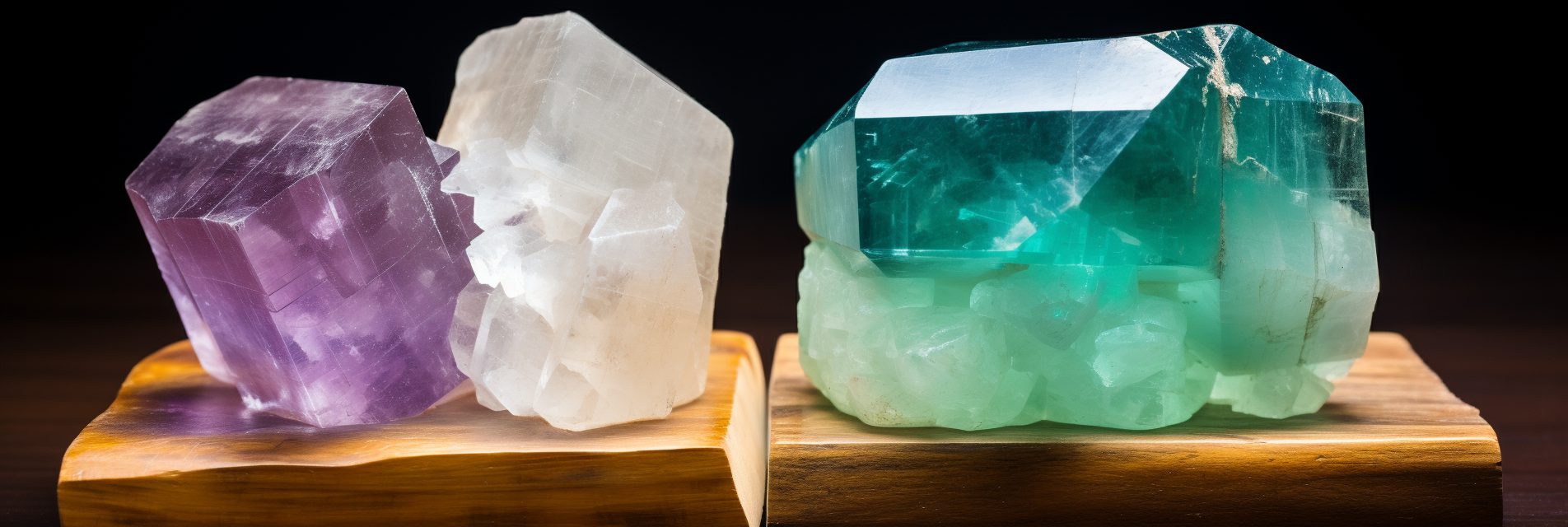
In the vast and vibrant world of gemology, stones often share similarities in aspects such as composition, color variations, and applications. In this section, we will draw parallels between fluorite and other similar stones, focusing on how they impact each other and their unique features. Here we compare fluorite with three other significant stones:
1. Quartz
Similarities: Both fluorite and quartz are sought after for their decorative and industrial uses. Their stunning visual appeal makes them popular choices in jewelry and home décor.
Differences: While fluorite has a cubic crystal system, quartz belongs to the trigonal crystal system, which gives it a hexagonal structure. Quartz is generally harder than fluorite, with a Mohs scale rating of 7 compared to fluorite’s rating of 4. Additionally, quartz is known for its piezoelectric properties, which are absent in fluorite.
Impact on Fluorite: The softer nature of fluorite as compared to quartz may influence it to be used in items that demand lesser durability and hardness.
2. Calcite
Similarities: Like fluorite, calcite is found in a wide array of colors and exhibits a remarkable play of light, which is loved by collectors and jewelers alike.
Differences: Calcite belongs to the trigonal crystal system and is softer than fluorite with a hardness of 3 on the Mohs scale. It reacts with acids, a property not shared with fluorite.
Impact on Fluorite: Being relatively harder, fluorite might be preferred in industries and applications where wear and tear are significant considerations.
3. Amethyst
Similarities: Both fluorite and Amethyst can be found in beautiful purple hues, which are very much appreciated in artistic and jewelry circles.
Differences: Amethyst, a variety of quartz, is more durable than fluorite due to its higher hardness rating on the Mohs scale. It is also historically revered as a precious gemstone, often associated with luxury and royalty.
Impact on Fluorite: Despite the lesser hardness, fluorite’s vivid color variations and lower price point can make it a more accessible alternative to amethyst for many consumers.
To conclude, fluorite, with its stunning colors and varied industrial applications, holds a significant place in the gemological world. Its comparison with stones like quartz, calcite, and amethyst showcases its versatile nature, which enables it to hold its ground firmly against these well-established stones.
Fun Fact: Fluorite is known as the ‘most colorful mineral in the world’ due to its vast array of brilliant colors.
Fluorite Stone: Care and Maintenance
Fluorite, with its captivating hues and crystal clarity, is a gemstone that embodies both beauty and vibrancy. While it is a sight to behold, it demands a certain level of care and maintenance to retain its allure over time. In this segment, we will venture into the ideal practices to preserve the brilliance of this fascinating stone.
Handling and Storage
Given its relatively low hardness on the Mohs scale, fluorite is prone to scratches and abrasions. Hence, it is recommended to handle it with utmost care. When storing, ensure to place it separately from other harder gemstones to prevent scratches. A soft fabric pouch can be used to store individual pieces.
Cleaning Procedures
- Step 1: Use a soft, lint-free cloth to remove any dust or particles from the surface.
- Step 2: Prepare a solution of mild soap and lukewarm water.
- Step 3: Using a soft brush, gently clean the fluorite stone with the soapy solution.
- Step 4: Rinse the stone thoroughly under running water to remove soap residues.
- Step 5: Pat it dry with a soft, clean cloth.
Note: It is essential to avoid the use of harsh chemicals or ultrasonic cleaners as they might damage the stone.
Temperature and Light Exposure
Fluorite can fade over time when exposed to direct sunlight for extended periods. To maintain its vibrant colors, store it in a place that does not receive direct sunlight. Also, extreme temperature fluctuations can cause the stone to fracture, hence keep it away from sources of extreme heat.
Regular Inspection
Regularly inspecting your fluorite pieces for signs of wear and tear can prevent potential damage. If set in jewelry, ensure that the settings are secure and free from any loose parts that might cause the stone to fall out.
Fluorite is a “fluorescent” mineral, which means it can glow in the dark when exposed to ultraviolet light. This is a property that can be used to verify its authenticity during maintenance checks.
In conclusion, proper care and maintenance are pivotal in preserving the beauty and longevity of fluorite stone. By adhering to these guidelines, you can enjoy the mesmerizing beauty of your fluorite pieces for many years to come.
Fluorite in Industrial Applications
Fluorite, also known as fluorspar, is not only a gem that dazzles in jewelry but also a critical mineral in various industrial applications. Its unique physical properties make it an indispensable resource across multiple industries. Let’s take a closer look at how this versatile mineral integrates into the industrial sector.
Metallurgical Industry
Fluorite is a pivotal mineral in the metallurgical industry, particularly in steel manufacturing. Due to its lower melting point, it assists in the smelting process and promotes the flow of slag, thus facilitating the production of steel and iron.
| Industry | Application | Beneficial Properties of Fluorite |
|---|---|---|
| Chemical Industry | Manufacture of hydrofluoric acid, a precursor to various fluorinated compounds including pharmaceuticals and polymers. | High fluoride content |
| Ceramic Industry | Used as a flux to lower the melting point of raw materials in glass production. | Fluxing properties, lowers melting point |
| Optical Industry | Utilized in the manufacture of high-quality lenses and optical equipment. | Low refractive index and high light transmittance |
Chemical Industry
Fluorite plays a significant role in the chemical industry, particularly in the production of hydrofluoric acid, which serves as a precursor to numerous fluorinated compounds, including pharmaceuticals and high-performance polymers. Its high fluoride content is pivotal in the synthesis of these chemicals.
Ceramic and Glass Industries
Within the ceramic and glass industries, fluorite is prized for its ability to act as a flux, lowering the melting point of raw materials and facilitating the formation of glass and ceramics with enhanced properties.
Optical Industry
Fluorite’s optical clarity and low refractive index make it a popular choice in the manufacturing of high-quality lenses and optical equipment. Its high light transmittance ensures the production of clear and sharp optical products.
Fun Fact: Fluorite has been used in the manufacturing of telescopes due to its ability to reduce the chromatic aberration, providing clearer images of celestial objects.
In a nutshell, fluorite’s unique physical and chemical properties make it a valuable asset across various industries, from metallurgy to optics. Its versatility indeed transcends its aesthetic appeal in the realm of gemstones.
Case Studies and Personal Narratives: Unveiling Fluorite Experiences
In this section, we delve deep into the lives of individuals who have had distinctive experiences with fluorite. Whether it be a jeweler, a geologist, or a regular individual entranced by its beauty, fluorite has touched the lives of many. Let’s explore some of these personal narratives and case studies that bring out the essence of fluorite.
A Geologist’s Pursuit of the Perfect Specimen
“In my decades-long career as a geologist, I have come across various minerals and gems. But nothing quite captured my heart like fluorite. Its luminous hues and the geometric perfection of its crystals made me dedicate years to finding the perfect specimen. After traversing through various mines across the globe, I finally found it in a secluded mine in China. It was a magical moment, a testament to fluorite’s elusive beauty.”
The Jeweler’s Masterpiece
“I have always been fascinated by the transcendent beauty of fluorite. Its palette of vibrant colors gives me a vast canvas to work on. One of my masterpieces is a necklace that combines fluorite’s different shades, creating a harmonious blend of earth’s colors. Every time someone adorns it, they can feel the soothing energies of the earth, a gentle reminder of our beautiful planet.”
An Artist Inspired
“As an artist, fluorite has been my muse for many art pieces. Its vibrant hues inspire a plethora of art forms, from canvas paintings to sculptures. I remember creating a sculpture based on fluorite’s cubic structure, which later became the centerpiece of an art exhibition. It’s amazing how a stone can ignite such a fire of creativity and appreciation for nature’s wonders.”
A Collector’s Pride
“My journey with fluorite began as a small child when I received a tiny fluorite crystal as a gift. Since then, my collection has grown exponentially, housing specimens from different corners of the world, each with a unique story to tell. To me, each piece is not just a stone; it’s a fragment of the earth’s history, a slice of the natural world’s magnificence.”
These narratives underscore the profound impact fluorite has on individuals from various walks of life. Its vibrant colors, geometric perfection, and the soothing energies it emanates, not only mesmerize but also inspire creativity and a deeper appreciation for the wonders of our planet.
Fluorite can foster a deep connection with the earth, offering a sense of peace and harmony to those who keep it close. It’s not just a mineral; it’s a source of inspiration and wonder, drawing people in with its unique charm and vibrant hues.
These stories resonate a common theme: fluorite’s captivating allure and its ability to foster a deep connection with the earth, offering tranquility and sparking creativity in those who encounter it.
Frequently Asked Questions
What are two facts about fluorite?
1. Fluorite is a highly colorful mineral, found in a range of colors, including purple, blue, green, yellow, and even clear varieties, making it a popular choice for ornamental and jewelry purposes.
2. Fluorite is renowned for its fluorescence, a phenomenon where it can glow under ultraviolet light, a property that is thought to be due to impurities in the mineral or defects in its crystal structure. This unique trait has inspired its name, which is derived from the Latin word “fluere”, meaning “to flow”.
Is fluorite a gem or stone?
Fluorite can be classified as both a gem and a mineral stone. It is a mineral composed of calcium fluoride and can be processed and polished to create stunning gem-quality pieces used in jewelry and ornamental crafts. Its vivid array of colors and its luminescent properties when exposed to ultraviolet light make it a coveted material in the gem industry.
How powerful is fluorite?
Fluorite is often heralded for its supposed spiritual and healing properties. Many believe that it can act as a protective stone, helping to ward off negative energies. It is also thought to aid in fostering clarity and focus, helping individuals connect with their inner selves and enhance their intuition. In the realm of physical properties, it holds a significant place in the industry due to its use in the manufacture of hydrofluoric acid and as a flux in the smelting of metallic ores. It’s a stone that marries both beauty and utility, making it quite powerful in different aspects.

